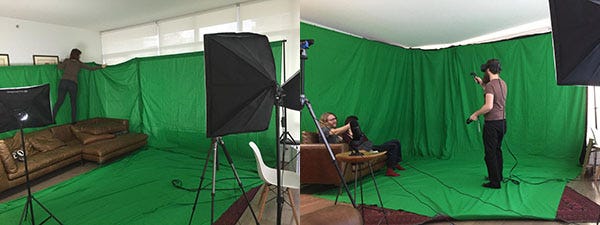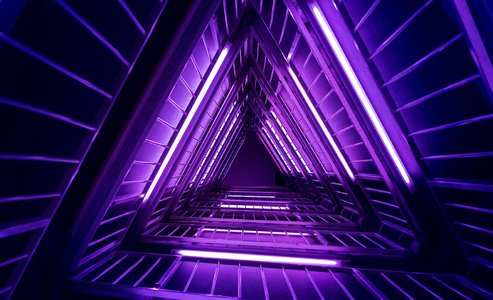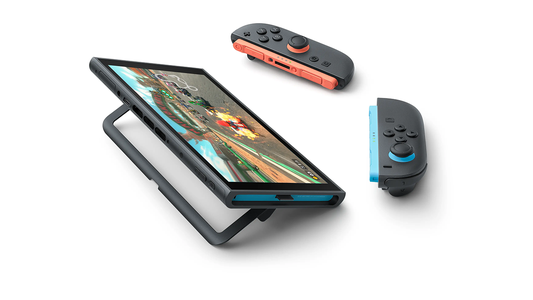This interview is part of our Road to the IGF series. You can find the rest by clicking here.
As a new dawn for commercial virtual reality brightens over the horizon, its light already shines brightest on the work of independent developers seeking to make the most of the platform. If you visit any conference or convention, you're just as likely to see an Oculus Rift or HTC Vive in the hands of small development teams with ramshackle setups as you are larger developers with expensive booths and long lines.
In a few months, all of these developers will get a chance to show off their creations as the Oculus Rift, Playstation VR, and HTC Vive make their commercial releases, but even before their launch, Northway Games and Radial Games' HTC Vive title Fantastic Contraption has already begun drawing notice for driving innovative design in virtual reality.
That inventiveness has scored Fantastic Contraption a nomination for the IGF Nuovo Award for Innovation in Game Design. Speaking with Gamasutra by e-mail, the combined Northway Games and Radial Games teams broke down the basics of where Fantastic Contraption came from, and why they think the VR experiences driven by the HTC Vive offer some of the best possibilities for game developers.
What's your background in making games?
Colin Northway: Sarah and I both studied computer science at the University of Victoria. Sarah worked at Three Rings in San Francisco while I made the original Fantastic Contraption in my spare time while working as a web developer. After a few years in San Francisco we decided to go post-national and spent five years traveling the world making indie games. On the road we made Incredipede, Word Up Dog, the Rebuild series, and Deep Under the Sky.
Lindsay Jorgensen: I started at Bioware and went from Modeling, to making tools for artists there, on Neverwinter through Jade Empire. Worked at Radical and Big Fish Games after that on progressively smaller teams getting more into drawing, graphics code, and messing with actual game code. I joined up with Radial Games a bit ago and helped finish Rocket Rockets Rockets. Now we're tag teaming with the Northways and I get to meddle with all aspects of making cool stuff happen in Fantastic Contraption.
Gordon McGladdery: I'm still a bit of a new kid. I did some music for Slick Entertainment's Shellrazer in 2012 while still at school at VFS--my first proper game--followed by Rogue Legacy the same year which really kickstarted everything. Over the past 2 years I've organically accumulated a bunch of my own gigs while still collaborating with Power Up on a few things and doing contracting in 2014-2015 at Klei working on Invisible, Inc. and Don't Starve, Shipwrecked. A Shell in the Pit Audio, now a fancy incorporated company, will be seeing multiple releases in 2016 including Fantastic Contraption, Okhlos, Viking Squad, Parkitect, Duelyst, Fossil Echo, Bunker Punks and another hush-hush project that is seriously neato.
Kimberly Voll: I've been making games in industry, independently and in academia over the last 20 years. I focus on player psychology and game design, as well as AI and gameplay programming.
Andy Moore : I've been making independent mobile and desktop video games since 2009 through my studio Radial Games. Previous titles include ROCKETSROCKETSROCKETS, Monster Loves You!, and SteamBirds.
What development tools did you use to build Fantastic Contraption VR?
Moore: “Unity” is the quick and easy answer. We have some great help from a few plugins (Wwise and InControl spring to mind) but we largely run vanilla. I feel like we’d be doing the VR platform a disservice though if we didn’t mention the amazing libraries and example code we’ve been provided with. Developing on new hardware is never easy but this was nearly plug-and-play right from day one, letting us get the physical stuff out of the way and get to work on the game itself.
How much time have you spent working on the game?
Colin Northway: We tried the Vive for the first time on June 12th, we started working of Fantastic Contraption on June 23rd and we got our first Vive to work with on July 20th. Before we had a Vive we just flew around a Vive controller with the keyboard and it was awful! But it did let us get to work on the game.
Moore : It feels like the game came together tremendously quickly, but we do have a blueprint (albeit a 2D one) in the form of the original web game. We knew the concept was fun and exciting, and we knew we didn’t need to iterate too much on gameplay itself to make a good experience. That allowed us to focus nearly all of our energy on technical and interface systems in this short ~6 months.
How did you come up with the concept?
Colin Northway: Fantastic Contraption VR is based on a game I made way back in 2007 (you can play it here for free: http://fantasticcontraption.com/original/). That game was inspired by other physics games, most heavily by Peter Stock's Armadillo Run and World of Goo. The twist that made the game came to me in a dream and I still have the notebook that I scrawled the idea into.
I've liked the idea of doing a 3D version of Fantastic Contraption for years but before I tried a Vive I didn't think it was possible.
Jorgensen : The idea behind the art has always been to accomplish a few goals, such as staying 'organic' as it's all too easy to default to gears and metal struts for this kind of game, but that's been explicitly avoided. Many decisions like that derive from the first game. It was a bit of a puzzle to figure out what the 'narrative' of the space was. The framing I landed on was a 'dreamspace' which lends itself to all sorts of interesting possibilities like being able to a tangential dimension using the helmet to solve some space problems, and let me go a bit crazy with things going on in the background. We also knew that it'd be a place you'd need to spend a lot of time in, solving all these puzzles, and it was really important that it be a pleasant and comfortable place.
Voll: I’ve been developing interactive media and researching in VR for several years now, particularly focusing on user experience in VR, and the notions of immersion, presence and engagement. One of the key outcomes of that work is that VR design has some huge, fundamental differences than traditional design. Instead of translating everything through controllers, you are able to maintain a near one-to-one mapping between how we move about the world in reality and VR. The same principles underlying engagement, challenge and agency as any other game, but our input mechanisms are so different. Building something is a natural way to tap into this, so when Colin suggested we collaborate to port Fantastic Contraption an immediate light went on that this would be the perfect project.

You and Sarah previously described the VR design process and that it was what enabled you to imagine a 3D version of the first Fantastic Contraption. What was it about Virtual Reality and the touch controllers that made the difference between this and a general 3D Fantastic Contraption release?
Colin Northway: Building 3D things on a 2D screen is very hard. This is what makes Infiniminer such a watershed game. Zach Barth figured out an easy, intuitive way to build 3D things in 2D. That's why Minecraft is so good, why Besiege works and why Zach's more recent game Infinifactory is so fun.
Fantastic Contraption isn't a game about blocks though, it's about sticks that change size and position all over the place, which leads to a simple problem: How do you use a mouse to decide the position, length, and rotation of an object in 3D space? There just isn't a fun answer to that.
But if you can move around in space and use your hands the answer to that becomes really fun! Imagine walking around your living-room building a thing with your hands that moves and changes and rolls off to interact with the world! When I first played Tilt Brush I loved making big sweeping motions and moving around in the space. Getting a different perspective on what I was making and reaching as high as I could to add a detail. When I realized Fantastic Contraption would have all those same motions I started to get really excited.
Moore: We put clumsy interfaces onto good 3D concepts all the time out of necessity. When you only have a 2D display or 2D inputs, you are going to need a layer of rotation and translation controls to get the output you want. This can be mastered, sure - look at any 3D artist, Unity developer, or even Kerbal Space Program - but it will never feel natural or be as quick as a building a Lego TIE Fighter.
With Fantastic Contraption, we didn't want the fun to come from a mastery of the inputs. It would put up a big barrier to entry for less experienced people, and it distracts from the core idea: building. Though a 2D display/2D input version would have been technically possible, it would have been so clumsy the game would have to fundamentally change to accommodate it.
How does the room-sized space players can walk around in that's generated by the HTC Vive integrate with your design process?
Jorgensen : The immediate immersion and freedom the space allows is spectacular. It allows so much use of your real world intuitions to be taken advantage of. How to move things around and grab and pull apart, and throw are so satisfying. The sense of self in the world to the point where most people are stepping over parts of their contraption, and physically moving around, ducking down to check out the alignment of wheels. Just being able to sit on the ground and look around, just because it's a pleasant place to 'be'. It blows me away every time. It transports you wholly to another world.
A big challenge for sure though is dealing with the variability of the size of space different users will have. There's a lot of temptation to clutter more and more stuff in, and tuck stuff here and there on the edge of some of the larger spaces, but it all has to work for users will smaller spaces too. Even not knowing how low people's ceilings might be in the worst cases has been a big concern.
Moore : We put clumsy interfaces onto good 3D concepts all the time out of necessity. When you only have a 2D display or 2D inputs, you are going to need a layer of rotation and translation controls to get the output you want. This can be mastered, sure - look at any 3D artist, Unity developer, or even Kerbal Space Program - but it will never feel natural or be as quick as a building a Lego TIE Fighter.
With Fantastic Contraption, we didn't want the fun to come from a mastery of the inputs. It would put up a big barrier to entry for less experienced people, and it distracts from the core idea: building. Though a 2D display/2D input version would have been technically possible, it would have been so clumsy the game would have to fundamentally change to accommodate it.
Voll: In VR as a player, you are actually building. You are picking objects up, looking at them, reasoning about them, and placing them in an incredibly real, human-like fashion...and it feels amazing. Something like that is simply impossible in non-VR 3D.
You've begun to pioneer shared reality Twitch streams---what do you feel the advantage is of these streams, and do you think this could be a foundation for other VR streaming titles?
Colin Northway: We are super excited about the mixed-reality streams! We've talked to a lot of people who have been trying to figure out how to show VR to people who haven't played it. It's such a hard thing to communicate. I think our streams are now coming closest to achieving that.
We're already talking to other games about sharing the tech and Twitch is very interested in getting more VR content. I think this is going to be a big part of the future of VR.

No tags.





































